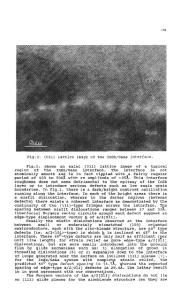Strain Evaluation of GaAs Layers Grown on Ultrahigh-Pressure-Annealed Strain-Free GaAs-On-Si Structures
- PDF / 351,437 Bytes
- 5 Pages / 414.72 x 648 pts Page_size
- 45 Downloads / 297 Views
TAKEHITO JIMBO AND HIROSHI ISHIWARA Precision and Intelligence Laboratory, Tokyo Institute of Technology, 4259 Nagatsuta, Midoriku, Yokohama 226, Japan
ABSTRACT In order to form strain-free GaAs films on Si substrates, GaAs-on-Si structures have been formed by molecular beam epitaxy (MBE) or metalorganic chemical vapor deposition (MOCVD) and subsequently annealed under ultrahigh pressure at 2 GPa. The samples were then reannealed at atmospheric pressure in order to investigate the regeneration effect of strain in the GaAs films. It was found from X-ray diffraction (XRD) analysis and photoluminescence (PL) measurement that in the reannealed samples the strain near the surface of GaAs film was smaller than that near the interface with Si. Finally, additional GaAs layers were grown using MBE on both as-grown and strain-free GaAs-on-Si structures and it was found that the residual strain in the GaAs layer on strain-free GaAs-on-Si structure was smaller than in the as-grown case.
INTRODUCTION The growth of GaAs-on-Si has received a great deal of attention because of its advantageous applications in novel electronic and photonic devices. In this structure, however, mismatch of the thermal expansion coefficient between the film and substrate is a serious problem for fabrication of minority carrier devices, since it produces residual defects even near the surface of the film. In order to solve the thermal mismatch problem in such heterostructures, we have proposed a novel
annealing method under ultrahigh pressure (UHP), which is based on a general property that a soft material has a relatively large thermal expansion coefficient [1,2). This method can be explained using a simple bimetal model as shown in Fig. 1 [2]. In this model, the thermal expansion coefficient c, of the film is assumed to be larger than the coefficient as of the substrate. Under these assumptions, the sample is bent downwards with decreasing temperature, as shown in Fig. 1(a). On the other hand, since the elastic strain in the film is also assumed to be larger than that of the substrate, the sample is bent upwards when
(a)
0
0u
(b)
0 0 0
0)
a.
a.,> a.
EDi (
l AT
Fig. 1. A bimetal model for explaining the annealing method at UHP. The thermal expansion aF of the film is assumed to be larger than the thermal expansion coefficient as of the substrate.
397 Mat. Res. Soc. Symp. Proc. Vol. 486 01998 Materials Research Society
the pressure is decreased from UHP, as shown in Fig. 1(b). Therefore, we can anticipate that the strain-free condition is realized by decreasing both temperature and pressure simultaneously, as shown in Fig. 1(b). We have already reported that the residual strain in UHP-annealed GaAs films, which are grown on Si substrates by metalorganic chemical vapor deposition (MOCVD) or molecular beam epitaxy (MBE), decreases linearly with increase of the pressure and that the strain-free film can be obtained at a pressure of around 2.0 GPa (20 kbar) [3,4]. We have also reported from X-ray diffraction (XRD) analysis and photolumines
Data Loading...










